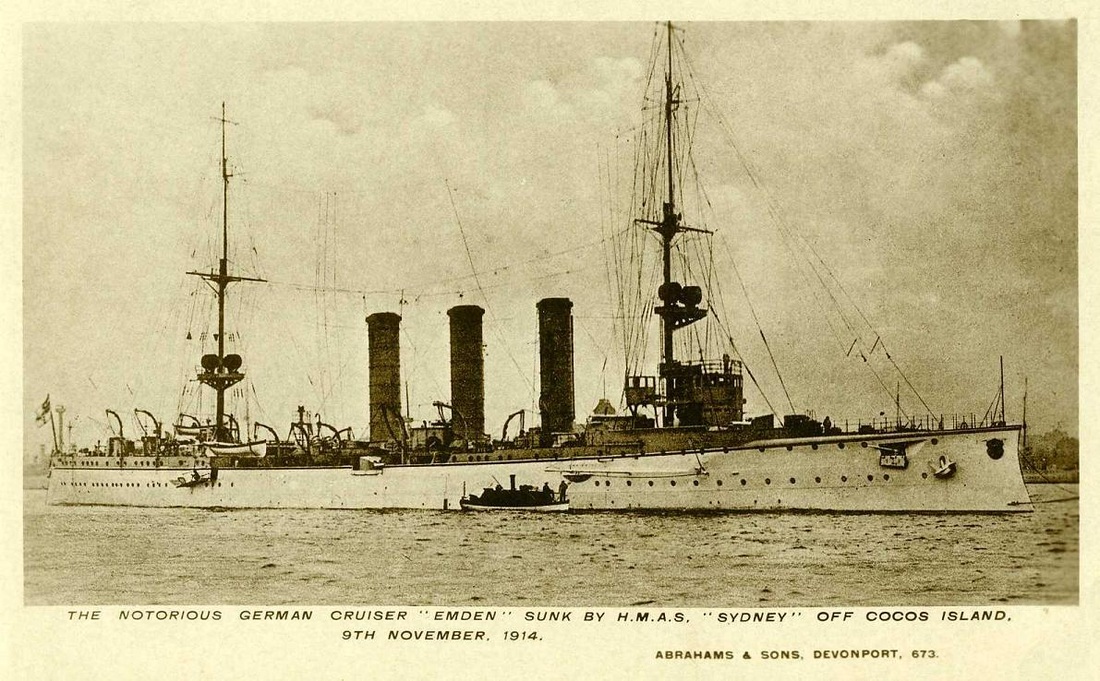IntroductionLast month I looked at the information covering the years of the Great War 1914 - 1918 contained in the business records of 'Naylor Hewitt Ltd'., fruitbrokers in Newcastle upon Tyne. In the continuation of this theme I will be looking at the other members of the Naylor family and the hair-raising maritime adventure that lay ahead of them as a result of the outbreak of war. The NaylorsCaroline Naylor was born in Newcastle to parents Charles Naylor and Sarah Welch in September 1885. The eldest of ten children she married Robert Johnstone in 1905. Through her father Charles, Caroline was a first cousin of Nathaniel Naylor jnr and Nathanial Naylor Hewitt the owners of the succesful business Naylor Hewitt Ltd, who featured in April's post 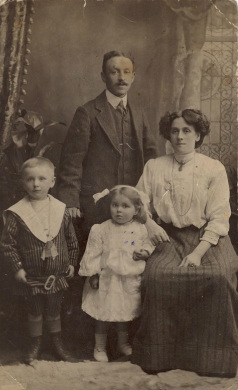 The Johnstone Family The Johnstone Family Charles was not a business man like his brother Nathanial, and father William. Although he appears on the census as a fruit brokers assistant, he also appears to have suffered periods of unemployment. Failing to find favour with his father he was effectively "written off" as Charles is not even worthy of a mention in William Naylor's will of 1871. Why this was the case we do not know. His brother Nathanial's business continued to flourish and by 1911 he was living at Haldane House in upmarket Jesmond, with 13 rooms a cook and a housemaid, Charles by contrast was living at 66 Derby Street, an out of work labourer,with his wife Sarah and five of his children in two rooms, one of which would have been the kitchen. Although local industries were making healthy profits, local people did not always share in this prosperity. Poverty was commonplace mainly as a result of low wages and irregular work. Many children went barefoot, and the poorest families relied on meals provided by the council or charities. People lived in fear of the poor law and the workhouse. There was no free healthcare, and infectious diseases were rife, often claiming many lives at a very young age. By the time of the 1911 census Charles & Sarah had lost four of their 10 children. Life would have been hard for the family and every penny that daughter Caroline brought home would have been welcomed. It comes as no surprise that her decision to emigrate to Australia with her husband and their young family caused a great deal of consternation. Not only financially, but war had broken out on the 28th of July making the ocean crossing even more perilous. Promising to return Caroline, husband Robert Johnstone and their two children Nora and Robert began their long journey from Newcastle to Adelaide on 26th August 1914 The Osterley & The Millers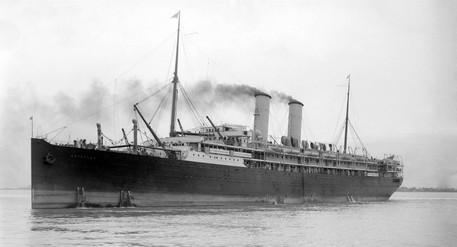 The RMS Osterley The RMS Osterley The "RMS Osterley" was built by the London & Glasgow Shipbuilding Co on the Clyde in 1909. She was operated by the Orient Steamship Navigation Company on the United Kingdom to Australia service. There was accommodation for 280 first class, 130 second class and 900 third class passengers. She was requisitioned in 1917 by the Australian Imperial Force (AIF). Coming through the war unscathed she was returned to commercial service in January 1919. During her time in operation the "Osterley" would run 59 voyages from the United Kingdom to Australia before being decommissioned and broken up in 1930. In 1914 she was under the command of Captain Jenks. On the 28th of August 1914 Caroline, Robert and their two children Nora and Robert Johnstone embarked as 3rd class passengers on the "Osterley" at the port of London. But all was not as it appeared, this is their entry in the passenger list:- As can been seen the family has adopted the name Miller and Robert Johnstone has changed his name to William. Not only that but what is even more curious is they describe themselves as residents of "British Possessions" in the 'Country of last Permanent Residence' column, and not England which is what I would have expected. A resident of a British Possession would indicate that they were last living in a British territory outside of the British Isles. This is without question our family as the personal recollections of the voyage and the events that ensued were recounted by Caroline Naylor to her grandchildren. It begs the question why the Johnstone family was travelling incognito? I firmly believe these inconsistencies are not mere errors, but are deliberate actions taken to prevent them from being traced. Caroline died in 1966 and her daughter Norah was unaware they had travelled under assumed names. It may have been due to the Naylor family's disapproval, because of the War, or it may have been so they would not be recognised in case disaster should strike, and their names appearing in the lists of those who perished?. I dare say we shall never know. "The Swan of the East"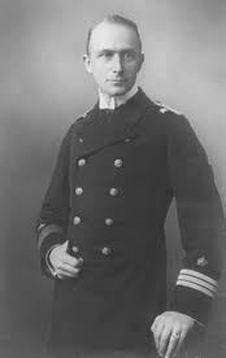 Karl von Muller Karl von Muller Meanwhile the outbreak of the War saw the withdrawal of the German Naval fleet from Asian waters. Amongst the fleet was the "SMS Emden" nicknamed "The Swan of the East", captained by Karl von Muller, a seasoned naval officer. Muller was granted permission to break free from the rest of the German Imperial Navy fleet who were making for home waters and headed some 2,000 miles South to the Indian Ocean, with only her collier ship for company. To conserve coal Muller used only six of the ships boilers and arrived in the Indian Ocean on September 6th, where he and his crew of 360 waged an astonishing piratical campaign for three months attacking British shipping with impunity. In the meantime the Osterley was steaming south, leaving Port Said on September the 8th heading for Columbo. Muller and his second command had a cunning trick. As most British men-of-war had either two or four funnels they disguised the Emden to resemble the British "HMS Yarmouth" by creating a fourth smoke stack out of wood and canvas. The ploy worked and by mid September the Emden had plundered and scuttled as many as 15 British vessels and was becoming known as the worlds most dangerous ship. Panic gripped the merchant fleet and all voyages between India and Syngapore were halted. A near miss.....The "Osterley" was now docked in Columbo, and a strange incident alerted Captain Jenks to the "Emdens" presence in the surrounding waters. It was generally agreed that the "Emden" was receiving information from neutral ships and when Captain Jenks spotted a ship entering the harbour flying a foreign flag only to leave a few hours later without having discharged or loading any cargo or coal his suspicions were aroused. When the "Osterley" left Columbo at midnight on the 13th September for Freemantle she did so in a complete blackout. Captain Jenks took the wise decision to vary his course to avoid Point de Galle, Sri Lanka. A wise decision indeed, as he later heard the "Emden" had been lying in wait, just 20 miles to the East. A near miss for the "Osterley" and her passengers. The memory of the fear during the blackout never left little Nora Johnstone, who was just 5 years old at the time. The path of destruction continuesDuring the following weeks the "Emden" continued to reek havoc and ground British trade in the Far East to halt. It terrorised the ports and sea lanes of more than a quarter of the Earth's surface. With shipping at a standstill Muller turned his attention to targets on land and on the night of 22nd September he steamed into the port of Madras and within 30 minutes oil tanks containing 350,000 gallons of fuel were destroyed. 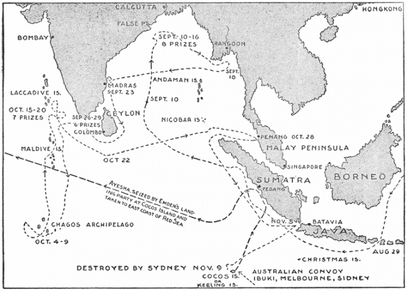 Cruise of the Emden 1914 Cruise of the Emden 1914 With the attack on Madras British prestige was dealt a mighty blow in its most prized colony. The British Admiralty was at loss as to how one single enemy cruiser could be creating so much damage. Winston Churchill then First Lord of the Admiralty ordered four cruisers, "Hampshire", Yarmouth" "Duplex" and "Chikuma " to devote themselves exclusively to hunting the "Emden". Muller had now set his sights on the British Port of Diego Garcia. He was amazed on arrival to discover the authorities there had no idea they were even at war! He took the opportunity to re-provision, repair and even repaint his ship. Muller returned this generosity by setting his own crew to work repairing the boat of a local resident. This was a reflection of the man, who was to become as famous for his gallantry as he was for his guile. His crew were under strict orders that all passengers and crew of the captured vessels be disembarked before blasting or scuttling the ship. The detainees were then treated as guests before being put ashore at a neutral port or transferred to neutral ships. The British Admiralty less than amused by these tales of chivalry that had the ladies swooning, had by the end of October no less than 60 ships in pursuit of Muller and the "Emden" The end of the "Emden"Muller now headed for the Cocos Islands, his objective the destruction of a British Telegraph station on the remote Direction Island. On Nov 9th Muller put a heavily armed landing party ashore, but thanks to the calm actions of an Eastern Telegraph employee who managed to get a distress signal out before the post was captured, the luck of "The Swan of The East" was about to run out. 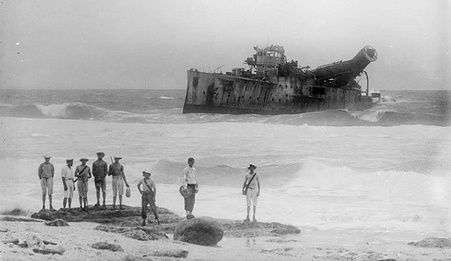 The ship that answered the call was the Australian ship HMAS Sydney just three hours away under the command of Captain John Glossop. Caught by surprise, Muller abandoned the shore party and ordered the "Emden" into action. Alas the "Sydney" was larger, stronger and crucially faster. With Muller's second in command and leading gunners with the landing party that had gone ashore, the "Emden" received in excess of 100 hits within the next 90 minutes. To avoid sinking Muller ordered the ship on to a reef, where she remained until 1960. The Captain of the Sydney continued to pour fire into the stricken ship before leaving to scuttle the "Emden's" collier the "Buresk". Unable to take her as a prize, or open fire upon her as there were two British cooks aboard, the German crew set about scuttling the Buresk themselves. Instead of a war prize Glossop was left with a few lifeboats in tow. Temper flaring he returned to "Emden" and opened fire on her again. By now the ship was reduced to a mangled mass of smouldering metal. Glossop then turned his attention to the landing party on Direction Island, again he was to be out done, they had commandeered an old schooner and were heading for Sumatra! During the attack, Muller lost 134 members of his crew and 65 others were seriously wounded. The "Sydney" did not return to rescue the survivors until 1.00pm the next day, and as is customary Muller was the last to leave his ship. It is then alleged that Capt Muller was piped aboard the "Sydney", with Glossop's arm around his shoulder and a tear in his eye. Glossop later admitted he had "felt like a murderer". The aftermathCapt Muller or "The Kaiser's Pirate" as he was affectionately know and his crew were taken as prisoners of war. When Muller was repatriated in 1918 he was hailed a hero. The Commander and all his fellow officers received the Iron Cross 1st class, the remainder of the crew the Iron Cross 2nd class, and the ship herself received the same honour. There continues to this day to be a ship in the German fleet by the name of "Emden". As for Caroline Johnstone she and her family arrived safely in Adelaide on the 3rd of October. She would not return to England until 1953 to visit family and friends. Her descendants still live in Australia with families of their own.
4 Comments
23/5/2014 01:53:38 pm
Susie as always I am gripped by your research!! Love it!!
Reply
Pamela
24/5/2014 01:32:20 am
HI Susie,
Reply
Susie Douglas
24/5/2014 06:25:14 am
Thanks for the great comments. A bit of additional information has come to light re Robert Johnstone. He apparently had been living in Adelaide from December 1911 and had returned home as his son was dangerously ill with pneumonia. I think this would explain the entry under "British Possessions" in the ships log.
Dinah Iredale
24/5/2014 02:36:49 pm
Enjoyed your new blog Susie. Very interesting and intriguing.
Reply
Leave a Reply. |
AuthorSusie Douglas Archives
August 2022
Categories |
Copyright © 2013 Borders Ancestry
Borders Ancestry is registered with the Information Commissioner's Office No ZA226102 https://ico.org.uk. Read our Privacy Policy

